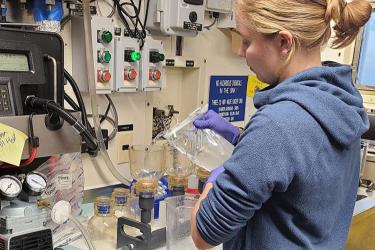One of the largest sea stars in the world, the sunflower sea star, was once common along the Pacific Coast of North America. Its sharp decline has prompted NOAA Fisheries to propose listing the species as threatened.
This proposal means that the sunflower sea star (Pycnopodia helianthoides) is considered likely to become in danger of extinction in the foreseeable future. The main threat to the species is a lethal pathogen that caused a recent outbreak of Sea Star Wasting Syndrome. It killed more than 90 percent of sunflower sea stars from 2013 to 2017 in what is considered the largest marine wildlife disease outbreak on record. Sea stars that contract the syndrome become lethargic, develop lesions, lose their arms, and within days disintegrate into gooey masses.
Sunflower sea stars reach up to 1 meter across from arm tip to arm tip, have up to 20 arms, and range from orange, to red, to purple or beige. Prior to the 2013 outbreak of wasting syndrome, they were one of the most abundant, widespread, and recognizable sea stars on the Pacific Coast. They were a familiar sight for tide-poolers and scuba divers throughout their range, which extends from the Aleutian Islands in Alaska to Baja California, Mexico. The species plays an important ecological role by helping control sea urchin populations in kelp forests and other vegetated nearshore habitats. Since 2017, the species has been rare south of Washington State and has disappeared almost entirely from Southern California shores, such as the Channel Islands.
While Sea Star Wasting Syndrome is not well understood, it appears to be exacerbated by rapid changes in water temperature, warmer ocean temperatures, and other physical stressors. Outbreaks are likely to recur as the climate continues to warm. Outbreaks may also be more frequent or spread more quickly. The Pacific Coast has experienced a series of marine heatwaves in recent decades. Between 2012 and 2016, the proportion of the global ocean experiencing strong or severe heatwaves increased from 30 percent to nearly 70 percent. The eastern Pacific marine heatwave, which affected waters from Alaska to California in 2014–16, coincided with several years of the 2013–2017 wasting syndrome outbreak and the die-off observed in sunflower sea stars. A causal link has not been firmly established.
Northern Waters May Offer Refuge
Populations of the species appear relatively more viable are in cooler, and possibly deeper, waters to the north, including Alaska, British Columbia, and the Salish Sea in the Pacific Northwest. Losses due to the syndrome in these waters were not as high as in more southerly waters. The historical abundance of sunflower sea stars from south of Cape Flattery, Washington is estimated to have been only 10 percent of the global population of the species.
“The science indicates that warmer temperatures and other stressors fueling disease are pushing this species towards an elevated risk of extinction,” said Chris Yates, Assistant Regional Administrator for Protected Resources in NOAA Fisheries’ West Coast Region. “Listing the species as threatened may not stop the warming, but it does mean that we will look for ways to conserve the species where it still has a chance to survive as part of our rich coastal ecosystem.”
Integral Species in the North Pacific Ecosystem
The Center for Biological Diversity submitted a petition to NOAA Fisheries in August 2021 requesting that the sunflower sea star be listed under the Endangered Species Act. In December 2021, NOAA Fisheries determined the petition provided substantial information suggesting the listing may be warranted. The review team examined the best scientific and commercial information available for the species to determine if listing was warranted.
Sunflower sea stars are voracious predators, consuming a wide array of benthic species, and can influence ecosystem structure by virtue of their predatory habits. They prey especially on sea urchins, which consume kelp and other marine vegetation that provide habitat for many nearshore species, sometimes during crucial life stages. Kelp forests have also disappeared from parts of California where the sunflower sea star has severely declined.
“This is a signature species of the North Pacific coastal ecosystem where so many of us have marveled at vibrant tidepools and towering kelp forests,” said Dayv Lowry, a fisheries biologist who led the status review of the species. “The sunflower sea star is an integral species that helps make this ecosystem what it is, and the proposed listing recognizes the grave threat the species currently faces.”




